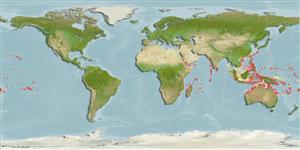Classification / Names
Common names from other countries
Main reference
Size / Weight / Age
Max length : 130 cm TL male/unsexed; (Ref. 9710); common length : 70.0 cm SL male/unsexed; (Ref. 9793); max. published weight: 46.0 kg (Ref. 2334)
Environment
Marine; reef-associated; depth range 1 - 40 m (Ref. 90102)
Climate / Range
Tropical, preferred 28°C (Ref. 107945); 30°N - 24°S
Distribution
Indo-Pacific: Red Sea and East Africa to Samoa and the Line Islands, north to the Yaeyama and Wake islands, south to the Great Barrier Reef and New Caledonia.
Countries | FAO areas | Ecosystems | Occurrences | Introductions
Short description
Dorsal
spines
(total): 9;
Dorsal
soft rays
(total): 10;
Anal
spines: 3;
Anal
soft rays: 9. Median predorsal scales 2 to 4 (may be obscured by hump); scales on cheek scale rows 1(4-6), 2(3-6), 3(1-2) (Ref. 9793). Sometimes confused with the humphead wrasse or other 'humphead' parrotfishes (Ref. 1602). Unlike the wrasse, it has a vertical head profile, and unlike other parrotfishes, it is uniformly covered except for the leading edge of the head which is often light green to pink, and has a nodular outer surface to its beak (Ref. 1602). The primary phase is a dull gray with scattered white spots, gradually becoming uniformly dark green (Ref. 1602).
IUCN Red List Status (Ref. 115185)
Threat to humans
Harmless
Human uses
Fisheries: commercial; aquarium: commercial
More information
ReferencesAquacultureAquaculture profileStrainsGeneticsAllele frequenciesHeritabilityDiseasesProcessingMass conversion
Tools
Special reports
Download XML
Internet sources
Estimates of some properties based on models
Phylogenetic diversity index
PD50 = 1.0000 many relatives (e.g. carps) 0.5 - 2.0 few relatives (e.g. lungfishes)
Trophic Level
2.7 ±0.41 se; Based on food items.
Resilience
Low, minimum population doubling time 4.5 - 14 years (K=0.10)
Vulnerability
High to very high vulnerability (67 of 100)
Price category
